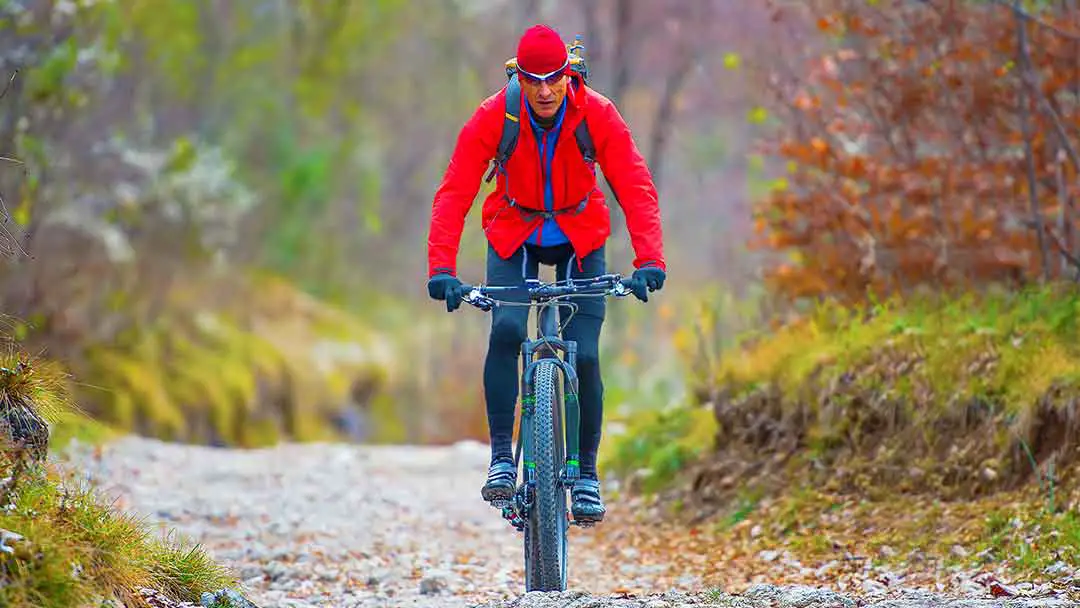How To Cycle Long Distances Without Getting Tired

As an Amazon Associate we earn from qualifying purchases made on our website. If you make a purchase through links from this website, we may get a small share of the sale from Amazon and other similar affiliate programs. You can read our complete legal information for more details. By using this site, you agree the information contained here is for informational purposes only. For specific medical questions, consult your doctor. NO information on this site should be used to diagnose, treat, prevent or cure any disease or condition.
Back when I was 12 or 13 years old, I experienced fatigue and cramps while playing soccer. I was fit and loved running, so I couldn’t understand why my body was getting worn out so quickly. My coach told me I needed to learn to breathe and eat like an athlete.
Per the experts, a proper, protein-rich diet is one of the primary cornerstones of sustained energy while cycling. Training and stretching your joints daily will also improve your endurance. Coupled with healthy sleep and training, you should experience better cycling endurance.
What should you eat while cycling long distances? How much water should you drink? Keep reading to learn more!
I also need to disclose that I am not a doctor or nutritionist. If you need medical and health advice, you must speak with your doctor. This article is not medical advice!
What Causes You To Get Tired While Cycling Long Distance?
One of the key ways to maintain your energy during a long-distance ride is to pace yourself. This means saving your energies for a later time rather than pushing your body to the limit right away.
While it may be tempting to make yourself ride through rugged terrain, it’s better to avoid these areas to prolong your ride.
Muscle fatigue, otherwise known as workout fatigue or burnout, is a physical and mental phenomenon. While fatigue can be associated with mental burnout, we will focus primarily on the physical causes of this sensation.
Per Healthline.com, some underlying causes of fatigue include the following conditions:
They also mention that these are the most common causes of fatigue. However, it can also be caused by underlying conditions such as:
- Flu or other illness
- Botulism
- Anaerobic Infections
- Cancer
- Thyroid issues
The primary distinction between these causes is how to address them. Some of these diseases are chronic and require medical treatment.
The second category falls under a chronic condition and must be treated by a medical professional and medication.
If you rule out a chronic condition, there are ways to address the underlying potential cause of your workout fatigue. This is where the first category falls and can usually be treated through lifestyle choices and proper care.
According to more nutritionists, some of the best ways to prevent fatigue caused by treatable conditions include:
- Eat plenty of protein
- Proper iron intake
- Proper amino acid intake
- Proper hydration
- Improved sleep patterns
- Breathing exercises
- Stretching
- Lighten the weight on the bike
We will discuss these treatments in further detail below. It is suggested by doctors to fuel your body and allow it adequate recovery time to maintain an active lifestyle.
For a long-distance ride, you need to pace yourself.
Don’t push yourself harder than you can. It’s better to travel for a longer period of time than to push yourself hard for two hours and burn out your muscles.

How Can You Properly Train For a Long Distance Bike Ride?
The most important part of training for your long-distance bike ride is building endurance.
Endurance can be built by incrementing exercises where you push yourself hard, or slow and steady endurance exercises.
Stationary bikes, which simulate biking in mountainous terrain, are one of the best places to start training for a long-distance bike ride.
Endurance is the ability to pursue a difficult experience that pushes the limits without quitting. This can be used to refer to mental and physical fortitude, which is built up over time through incremental training.
Regards to cycling, this involves several components which will help you train for this unique exercise:
- Proper stretching
- Periodic training several times per week
- Gradual building of muscle
- Gradual building of endurance
One of the essential components of training includes the ability of the body to build upon previous abilities. The simplest way to see this capacity is something like this:
- Day one of training:
- 25% muscle mass
- Ability to workout for 45 minutes before body wears out
- Day ten of training:
- 28% muscle mass
- Ability to workout for 1 and a half hours before wearing out
- Day 30 of training
- 32% muscle mass
- Ability to workout for 2 to 2 ½ hours before wearing out
The list goes on. This isn’t a precise medical breakdown of how the body’s condition improves as you continue working out.
This is simply used to illustrate why training is important and how it allows cyclists to perform better on a long-distance rides.
Therefore, proper exercise and consistent training are the best ways to cycle longer without wearing out.
Stretching is super important too. Stretching releases tension in the joints and allows the muscles to relax and feel rejuvenated.
Most fitness trainers agree stretching is beneficial for the following reasons:
- Can help prevent injury
- Can help prevent painful recovery
- Promotes full mobility
- Promotes mobility in old age
Some say that failure to properly stretch before an intense bike ride can cause cramping and other types of muscular damage.
It can also cause you to feel tired and fatigued earlier than you otherwise would if you stretched properly.

What Are the Signs of Overtraining?
Overtraining is exhibited in the body by extreme muscle soreness, which is beyond the normal range of pain.
This can be felt in the legs, arms, or other regions, depending on what parts of the body were exerted.
For cycle training, the pain is most likely to be felt in the legs, particularly in the thighs and knees.
Per HSS.edu overtraining is defined as overexerting your body’s capabilities and muscle’s capacities. It puts excessive stress on the body without proper rest and recuperation time.
The best way to prevent overtraining is to know your limits and avoid pushing yourself too far beyond them.
This doesn’t mean you shouldn’t push yourself beyond your limits, but it does mean you need to be careful when doing so.
Secondly, always allow your body proper recovery times. Of course, while you’re on a cycle tour or bikepacking excursion, you might not be able to take a day or two off.
However, this is why it’s so important to pace yourself and avoid over-exertion.
How do You Keep Your Energy Up When Cycling?
Proper food and rest are the cornerstones of maintaining energy levels while cycling long distances.
A high-carb, processed food, and low-protein diet might seem the most appealing, but it can quickly lead to fatigue.
Additionally, poor sleeping gear and inferior camp gear can lead to a disruptive and insufficient night’s sleep.
Check out these three guides for some help:
- Complete Bike Touring Cooking Guide
- Bikepacking Water Storage Guide
- Bike Touring Packing List (Printable PDF)
What to Eat
Some cycling sites advocate for a diet rich in carbohydrates and sugars. While these foods might be filling, they’re not nutrient-dense foods, which is necessary for long-distance cycling.
We advocate for a diet rich in protein, amino acids, electrolytes, vitamins, and minerals.
These primary nutrients will help you keep moving longer and build muscle. This will help improve your endurance.
Protein is an important part of all aspects of your body. We often think of it as simply something we eat when we want more muscles.
While this is certainly true, protein also helps your body function properly. It’s a vital part of the immune system and blood cell movement.
Protein is created by amino acids, which are often found along with protein in our foods.
Most trainers these days recommend eating meats such as fish, pork, and beef for your meals.
Here are two snacks I recommend with discount codes to save some mullah.
- Redmond Re-Lyte Electrolyte Mix (15% Discount)
- Carnivore Crisps, Dehydrated Meat without Additives or Sugar (10% Discount)
You can type in WILD at checkout for the two stores listed above if you prefer!
How Much to Sleep
Sleep is an essential part of the body’s regulatory system. It helps your mind unwind, bolsters your immune system, and promotes balanced hormonal levels.
Naturally and according to sleep experts, a lack of sleep or poor sleep quality can cause the following ailments:
- Cardiovascular issues
- Decreased energy levels
- Difficulties breathing
- Irritability
- Decreased reaction times
- Depression
- Obesity
- Hallucinations
What I’ve learned is that a lack of sleep or poor sleep quality can dramatically impact your cycling performance.
First, it will significantly impact your energy levels. Regardless of how much training you go through and how well you’re eating, you will have an elevated heart rate if you don’t sleep well.
Second, sleep deprivation is closely linked to hallucinations and decreased reaction times. Obviously, this can increase the possibility of accidents and injury.
Finally, poor sleep quality messes with your hormones. This can cause you to experience weight gain and increased appetite.

Travel Light
Keep the amount of weight you carry limited. Excess weight will waste energy and calories, which could better be used to power your bike.
The best ways to limit the weight on your bike include the following:
- Carry dehydrated food
- Carry optimized tents and/or hammocks
- Avoid bringing more than four outfits
- Carry enough water for two days, no more unless necessary
Check out this bike weight distribution guide for some help.
Fluids
Dehydration is a serious condition that occurs when the body’s fluids aren’t being properly restored. When you’re working out or utilizing high amounts of energy, your body releases sweat to cool off the body.
Sweat is an integral part of your body’s regulatory system. Without it, our bodies would quickly overheat, and we’d succumb to heat stroke.
However, it’s just as important to replenish this water. Make sure you consistently replenish fluids while you’re cycling throughout the day.
Signs of dehydration include:
- High heart rate
- Passing out
- Dry skin
- Lack of elasticity in your veins
Depending on my biking adventure, I always bring either water purification tablets or a water purifier like this GRAYL water bottle filter.
Proper Breathing
Proper breathing is one of the critical components of maintaining energy levels. Breathing properly will help keep your blood pressure regulated while you work out.
I’m told shallow breathing can cause you to get cramps and experience numbness in your legs and arms.
Bike racers say to be sure you’re taking deep breaths, which enter your lungs and are expelled throughout the body.

Closing Thoughts
We all want to keep going once we start working out. Something about getting into the zone makes you want to keep up the momentum!
Just make sure you don’t burn yourself out! Cycling long distances and keeping a healthy energy level is better than high speed and quick burnout.
Keep up the work, and you’ll feel your energies improved!
Here are two more helpful articles:
Sources:
Healthline: What Causes Muscle Fatigue?
Healthline: What to Know About Dehydration
Healthline: Mineral Deficiency
Healthline: The Effects of Sleep Deprivation on Your Body
Healthline: Everything You Need to Know About the Flu’
Healthline: Anaerobic Infections
Endurance Bike and Run: How can I cycle further without getting tired?
TDA: 8 TRAINING TIPS FROM OUR LONG DISTANCE CYCLISTS
Mayo Clinic: Stretching: Focus on flexibility
HSS: Overtraining: What It Is, Symptoms, and Recovery
National Heart, Lung, and Blood Institute: Why Is Sleep Important?



